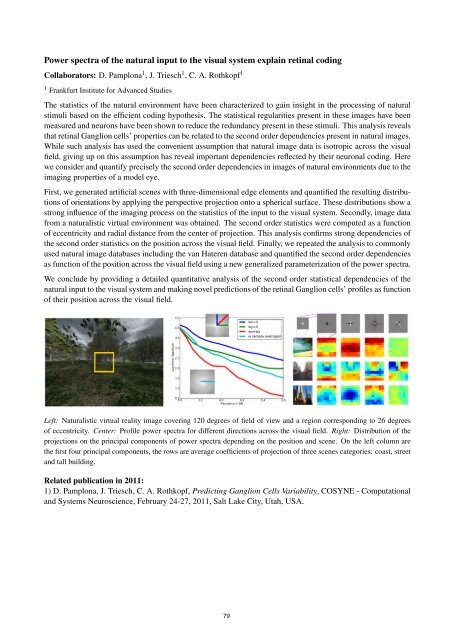FIAS Scientific Report 2011 - Frankfurt Institute for Advanced Studies ...
FIAS Scientific Report 2011 - Frankfurt Institute for Advanced Studies ...
FIAS Scientific Report 2011 - Frankfurt Institute for Advanced Studies ...
Create successful ePaper yourself
Turn your PDF publications into a flip-book with our unique Google optimized e-Paper software.
Power spectra of the natural input to the visual system explain retinal coding<br />
Collaborators: D. Pamplona 1 , J. Triesch 1 , C. A. Rothkopf 1<br />
1 <strong>Frankfurt</strong> <strong>Institute</strong> <strong>for</strong> <strong>Advanced</strong> <strong>Studies</strong><br />
The statistics of the natural environment have been characterized to gain insight in the processing of natural<br />
stimuli based on the efficient coding hypothesis. The statistical regularities present in these images have been<br />
measured and neurons have been shown to reduce the redundancy present in these stimuli. This analysis reveals<br />
that retinal Ganglion cells’ properties can be related to the second order dependencies present in natural images.<br />
While such analysis has used the convenient assumption that natural image data is isotropic across the visual<br />
field, giving up on this assumption has reveal important dependencies reflected by their neuronal coding. Here<br />
we consider and quantify precisely the second order dependencies in images of natural environments due to the<br />
imaging properties of a model eye.<br />
First, we generated artificial scenes with three-dimensional edge elements and quantified the resulting distributions<br />
of orientations by applying the perspective projection onto a spherical surface. These distributions show a<br />
strong influence of the imaging process on the statistics of the input to the visual system. Secondly, image data<br />
from a naturalistic virtual environment was obtained. The second order statistics were computed as a function<br />
of eccentricity and radial distance from the center of projection. This analysis confirms strong dependencies of<br />
the second order statistics on the position across the visual field. Finally, we repeated the analysis to commonly<br />
used natural image databases including the van Hateren database and quantified the second order dependencies<br />
as function of the position across the visual field using a new generalized parameterization of the power spectra.<br />
We conclude by providing a detailed quantitative analysis of the second order statistical dependencies of the<br />
natural input to the visual system and making novel predictions of the retinal Ganglion cells’ profiles as function<br />
of their position across the visual field.<br />
Left: Naturalistic virtual reality image covering 120 degrees of field of view and a region corresponding to 26 degrees<br />
of eccentricity. Center: Profile power spectra <strong>for</strong> different directions across the visual field. Right: Distribution of the<br />
projections on the principal components of power spectra depending on the position and scene. On the left column are<br />
the first four principal components, the rows are average coefficients of projection of three scenes categories: coast, street<br />
and tall building.<br />
Related publication in <strong>2011</strong>:<br />
1) D. Pamplona, J. Triesch, C. A. Rothkopf, Predicting Ganglion Cells Variability, COSYNE - Computational<br />
and Systems Neuroscience, February 24-27, <strong>2011</strong>, Salt Lake City, Utah, USA.<br />
79
















